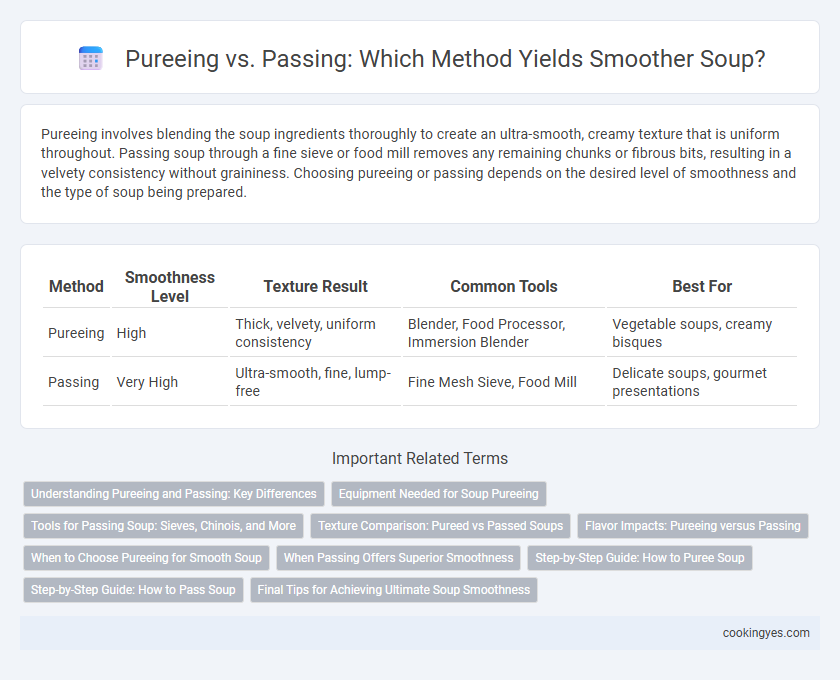Pureeing involves blending the soup ingredients thoroughly to create an ultra-smooth, creamy texture that is uniform throughout. Passing soup through a fine sieve or food mill removes any remaining chunks or fibrous bits, resulting in a velvety consistency without graininess. Choosing pureeing or passing depends on the desired level of smoothness and the type of soup being prepared.
Table of Comparison
| Method | Smoothness Level | Texture Result | Common Tools | Best For |
|---|---|---|---|---|
| Pureeing | High | Thick, velvety, uniform consistency | Blender, Food Processor, Immersion Blender | Vegetable soups, creamy bisques |
| Passing | Very High | Ultra-smooth, fine, lump-free | Fine Mesh Sieve, Food Mill | Delicate soups, gourmet presentations |
Understanding Pureeing and Passing: Key Differences
Pureeing blends all soup ingredients into a thick, uniform texture using a blender or food processor, intensifying flavors and providing a rich mouthfeel. Passing involves pushing the soup through a fine sieve or chinois, removing solids for a velvety consistency without fully blending the components. This refinement technique preserves delicate textures, ideal for elegant consommes or bisques requiring exceptional smoothness.
Equipment Needed for Soup Pureeing
Achieving a smooth soup texture depends heavily on the equipment used for pureeing, with high-powered blenders offering the finest consistency by thoroughly breaking down ingredients into a velvety blend. Food processors provide a slightly coarser result suitable for chunky soups, while immersion blenders allow for quick, in-pot pureeing without transferring contents, preserving heat and minimizing cleanup. Passing soup through a fine mesh sieve or food mill further refines texture by removing any remaining solids, ideal for ultra-smooth bisques and veloutes.
Tools for Passing Soup: Sieves, Chinois, and More
Using specialized tools like sieves and chinois significantly enhances the texture and smoothness of soups by effectively removing solids and fibrous materials. A chinois, with its fine conical mesh, is ideal for producing ultra-smooth purees, while traditional sieves offer versatile options for varying levels of refinement. Employing these tools ensures a velvety finish, elevating the quality and presentation of pureed soups.
Texture Comparison: Pureed vs Passed Soups
Pureed soups have a creamy, dense texture created by blending all ingredients until smooth, providing a rich mouthfeel and uniform consistency. Passed soups, strained through a fine sieve or chinois, achieve an ultra-smooth, velvety texture by removing fibrous bits and seeds, resulting in a delicate and refined finish. The choice between pureeing and passing affects the soup's mouthfeel, with pureed soups offering body and substance, while passed soups deliver a silkier, lighter experience.
Flavor Impacts: Pureeing versus Passing
Pureeing soup blends all ingredients together, intensifying flavors but sometimes masking subtle notes due to the full breakdown of solids. Passing soup through a fine sieve or tamis removes skins and seeds, resulting in a silkier texture with a cleaner, more refined taste that highlights individual flavor components. The choice between pureeing and passing significantly influences both the mouthfeel and flavor clarity of the final dish.
When to Choose Pureeing for Smooth Soup
Choose pureeing for smooth soup when you want a creamy, thick texture that blends all ingredients fully, such as in bisques or cream-based soups. Pureeing breaks down fibers and solids completely, resulting in a velvety consistency ideal for soups containing softer vegetables like pumpkin, carrot, or squash. This method enhances flavor integration and ensures a consistent mouthfeel, perfect for rich, smooth soup varieties.
When Passing Offers Superior Smoothness
Passing soup through a fine sieve or chinois offers superior smoothness by removing fibrous bits and seeds that pureeing alone cannot eliminate. This technique is ideal for delicate soups like bisques and veloutes, where an ultra-silky texture enhances the dining experience. Passing creates a refined, polished mouthfeel that pureeing often lacks due to retained pulp and tiny solids.
Step-by-Step Guide: How to Puree Soup
To achieve a perfectly smooth soup, start by cooling the cooked ingredients slightly before blending to prevent splattering. Use an immersion blender or transfer the soup in batches to a countertop blender, blending until the desired texture is achieved. Strain the pureed soup through a fine mesh sieve to remove any remaining solids, ensuring a creamy, velvety consistency.
Step-by-Step Guide: How to Pass Soup
To achieve the smoothest texture when passing soup, start by setting up a fine mesh sieve or chinois over a large bowl. Ladle the cooked soup into the sieve and use a rubber spatula or a wooden spoon to gently press and stir the mixture, allowing the liquid to pass through while leaving solids behind. Repeat the process in small batches until all soup is strained, ensuring a velvety, lump-free consistency ideal for refined presentation and mouthfeel.
Final Tips for Achieving Ultimate Soup Smoothness
For achieving ultimate soup smoothness, pureeing with an immersion blender or high-speed blender creates a creamy texture by completely breaking down ingredients, while passing soup through a fine-mesh sieve refines the texture by removing any remaining solids. Combining both methods ensures maximum silkiness and velvety consistency, especially for bisques or creamy vegetable soups. Maintaining appropriate soup thickness before blending and chilling slightly before passing can improve the final smoothness and flavor integration.
Pureeing vs Passing for Smoothness Infographic

 cookingyes.com
cookingyes.com